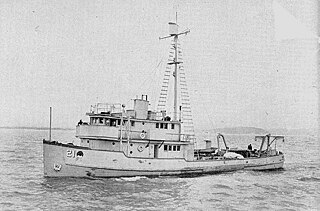USS Adamant (AMc-62) was an Accentor-class minesweeper in the United States Navy during World War II.
USS Bunting (AMc-7) was a coastal minesweeper in the United States Navy. She was named after the bunting, a seed-eating bird intermediate in size between starlings and finches.
USS Sanderling is a name the United States Navy has used more than once in naming its vessels:
USS PCS-1465 was a PCS-1376-class minesweeper built for the United States Navy during World War II. Late in the war she was renamed and reclassified Minah (AMc-204), and in the 1950s reclassified first as AMCU-14 and later as MHC-14. Named for the myna under a variant spelling, she was the only U.S. Navy ship of that name.
USS Pipit (AMc-1) was a Pipit-class coastal minesweeper acquired by the United States Navy for use in World War II. Her task was to clear minefields in coastal waterways.
USS Magpie (AMc-2) was a Pipit-class coastal minesweeper acquired by the United States Navy for use in World War II. Her task was to clear minefields in coastal waterways.
USS Plover (AMc-3) was a Pipit-class coastal minesweeper acquired by the United States Navy for use in World War II. Her task was to clear minefields in coastal waterways.
USS Crossbill (AMc-9) was a coastal minesweeper of the United States Navy. Built in 1937 as North Star by the Watchorn Yacht and Boat Works, San Pedro, California, the ship was acquired by the U.S. Navy on 31 October 1940, and commissioned as USS Crossbill on 22 March 1941. Crossbill operated in an in-service status attached to the 14th Naval District from 1941 to 1947. Crossbill was decommissioned in 1947. Fate unknown.
USS Longspur (AMc-10) was a coastal minesweeper of the United States Navy. Built by the Martinac Shipbuilding Co., Tacoma, Washington, as New Ambassador in 1935, the ship was acquired by the U.S. Navy on 30 October 1940; converted by South Coast Shipyard, Newport Beach, California; and placed in service on 11 April 1941.

USS Waxbill (AMc-15) was a coastal minesweeper of the United States Navy. The ship was built as a commercial wooden-hulled purse seiner at Fulton Shipyard in Antioch, California in 1936.

USS Reliable (AMc-100) was an Accentor-class coastal minesweeper acquired by the U.S. Navy for the dangerous task of removing mines from minefields laid in the water to prevent ships from passing.
USS Radiant (AMc-99) was an Accentor-class coastal minesweeper acquired by the U.S. Navy for the dangerous task of removing mines from minefields laid in the water to prevent ships from passing.
USS Prestige (AMc-97) was an Accentor-class coastal minesweeper acquired by the U.S. Navy for the dangerous task of removing mines from minefields laid in the water to prevent ships from passing.

USS Memorable (AMc-89) was an Accentor-class coastal minesweeper acquired by the U.S. Navy for the dangerous task of removing mines from minefields laid in the water to prevent ships from passing.
USS Pintail (AMc-17) was a coastal minesweeper acquired by the U.S. Navy for the dangerous task of removing mines from minefields laid in the water to prevent ships from passing.
USS Grosbeak (AMc-19) was a Grosbeak-class coastal minesweeper acquired by the U.S. Navy for the dangerous task of removing mines from minefields laid in the water to prevent ships from passing.

USS Killdeer (AMc-21) was a unique coastal minesweeper acquired by the U.S. Navy for the dangerous task of removing mines from minefields laid in the water to prevent ships from passing.
USS Firecrest (AMc-33) was a Firecrest-class coastal minesweeper acquired by the U.S. Navy for the dangerous task of removing mines from minefields laid in the water to prevent ships from passing.
USS Parrakeet (AMc-34) was a coastal minesweeper acquired by the U.S. Navy for the dangerous task of removing mines from minefields laid in the water to prevent ships from passing.

USS Road Runner (AMc-35) was a coastal minesweeper acquired by the U.S. Navy for the task of removing mines from minefields laid in the water to prevent ships from passing.




